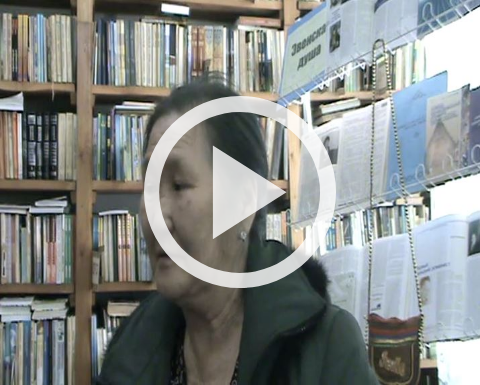- Книга (1232)
- Журнал (5)
- Автореферат диссертации (64)
- Аудиоиздание (11)
- Видеоиздание (65)
- Неопубликованный документ (2)
- Нотное издание (3)
- Фотография (11)
- Статья (364)
- Библиографический указатель (13)
- Словарь (2)
- Календарь (1)
- Брошюра (23)
- Буклет (12)
- Электронное издание (2)
- 3D-модель (15)
- Грампластинка (5)
- Веб-архив (231)
Год выпуска: 2015
Год выпуска: 2015
- Медиатека НБ Якутии: смотри и слушай > Видеозал: видеосюжеты, фильмы, мультфильмы, буктрейлеры > Якутия: история, культура, природа,
- Национальная культура, обряды, праздники коренных малочисленных народов Севера > Традиционные обряды, праздники, искусство коренных малочисленных народов Якутии > Эвены,
- Общественные науки. Образование,
- КНИГАКАН > Все народы > Эвены (тунгусо-маньчжурская группа языков) > Этнография. Фольклор.
Количество страниц: 15 с.
Dobzhanskaya, O/ E. The Living Has Sound. The Dead Is Silent / Oksana E. Dobzhanskaya ; Moscow State University // Anthropology & archeology of Eurasia. - 2016, Т. 55, N 1. - С. 7-21. - DOI: http://dx.doi.org/10.1080/10611959.2016.1263485
DOI: http://dx.doi.org/10.1080/10611959.2016.1263485
Год выпуска: 2015
Год выпуска: 2015
- Сказочный мир > Сказки народов Севера и авторские сказки,
- Сказки Северного сияния,
- Медиатека НБ Якутии: смотри и слушай > Видеозал: видеосюжеты, фильмы, мультфильмы, буктрейлеры > Детям,
- Общественные науки. Образование,
- КНИГАКАН > Все народы > Эвены (тунгусо-маньчжурская группа языков) > Художественная литература. Поэзия.
Год выпуска: 2015
- Оленевод - хранитель тундры > Стадо - основная форма содержания оленей,
- Медиатека НБ Якутии: смотри и слушай > Видеозал: видеосюжеты, фильмы, мультфильмы, буктрейлеры > Якутия: история, культура, природа,
- Общественные науки. Образование,
- КНИГАКАН > Все народы > Эвены (тунгусо-маньчжурская группа языков) > Общественные науки.
Год выпуска: 2015
- Медиатека НБ Якутии: смотри и слушай > Видеозал: видеосюжеты, фильмы, мультфильмы, буктрейлеры > Якутия: история, культура, природа,
- Национальная культура, обряды, праздники коренных малочисленных народов Севера > Традиционные обряды, праздники, искусство коренных малочисленных народов Якутии > Эвены,
- Общественные науки. Образование,
- КНИГАКАН > Все народы > Эвены (тунгусо-маньчжурская группа языков) > Этнография. Фольклор.
Год выпуска: 2018
В 1997 и в 2017 годах в Эвенкии были проведены комплексные исследования по современным этническим процессам с использованием метода массового опроса. Выявлены существенные изменения в хозяйстве, в разных областях материальной и духовной культуры. Резко снизилось значение оленеводства, в настоящее время в нем заняты около 1/10 части эвенкийских семей. Лучше сохранились охота и рыболовство, в них занята почти треть мужчин. На любительском уровне охотой и рыболовством занимается подавляющее большинство мужчин, а значительная часть женщин не утеряли навыков шитья и вышивки бисером. Активно идет процесс языковой ассимиляции, дети практически не говорят на языке эвенков и не понимают его, хотя большинство эвенков изучает родной язык в школе. Количество национально-смешанных семей, в основном с русскими, приблизилось к половине всех семей, большинство детей вливаются в эвенкийский этнос. В результате этих браков доля метисов среди эвенков приближается к 2/3, а среди детей их доля достигла 9/10. Эвенки превращаются в группу русскоязычных метисов, но с устойчивым этническим самосознанием и с сохранением элементов традиционной культуры в некоторых областях материальной и духовной культуры
Год выпуска: 2022
Целью и задачами статьи является выявление основных способов перевода на русский текста якутского героического эпоса олонхо "Ала-Булкун", осуществленного якутским лингвистом и писателем Г.В. Баишевым-Алтан-Сарын (1898-1931). В качестве материала исследования были выбраны глаголы движения и некоторые основные эпические формулы, использованные в данном олонхо. Анализ способов перевода на русский язык якутских глаголов движения показывает, что эти глаголы переведены на русский язык способом замены. Подобный факт свидетельствует о том, что переводчик стремился точно передать семантику якутских глагольных форм на русский язык. Это, свою очередь, обусловлено тем, что глагольные формы как предикативные структуры являются вершинами тех или иных предикативных конструкций – зависимых или независимых. Эпические формулы переведены при помощи синтаксической замены – параллелизмами, а также расчленением предложения на несколько предложений. Кроме того, встречаются лексические и синтаксические повторы для расширения контекста с целью более медленного раскрытия передаваемой информации. Установлено, что в рассмотренном переводном тексте имеют место элементы авторизованного перевода. Изучение особенностей подобных переводов олонхо, ориентированных на воспроизведение стилистических и поэтических особенностей данного жанра якутского фольклора, имеет как практическое, так и теоретическое значение
Год выпуска: 2022
Настоящая статья представляет формирование субэтнической группы якутов в исследовательской траектории: ландшафт, история, память и посвящена изучению периферийной этнолокальной группы ессейских якутов, компактно проживающих на озере Ессей Красноярского края с XVIII века. На основе полевых материалов реализованы методы опроса, картографирования, глубинного интервью, введены в научный оборот ранее не опубликованные архивные материалы, нарративные источники









